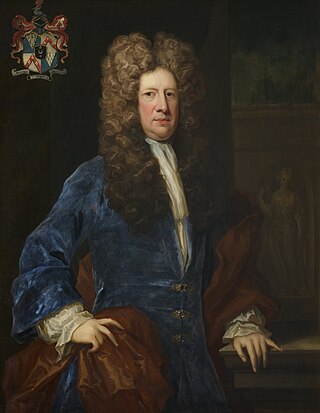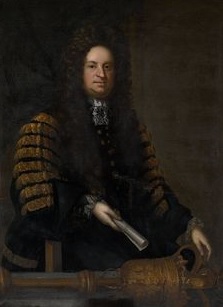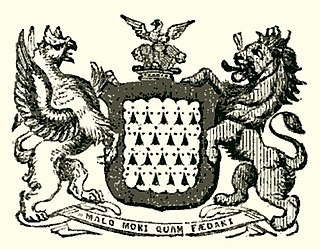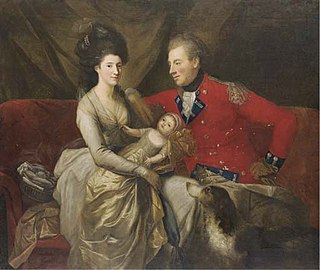| |||||
| Centuries: | |||||
|---|---|---|---|---|---|
| Decades: | |||||
| See also: | Other events of 1695 List of years in Ireland | ||||
Events from the year 1695 in Ireland.
| |||||
| Centuries: | |||||
|---|---|---|---|---|---|
| Decades: | |||||
| See also: | Other events of 1695 List of years in Ireland | ||||
Events from the year 1695 in Ireland.

.

Earl of Cork is a title in the Peerage of Ireland, held in conjunction with the Earldom of Orrery since 1753. It was created in 1620 for Richard Boyle, 1st Baron Boyle. He had already been created Lord Boyle, Baron of Youghal, in the County of Cork, in 1616, and was made Viscount of Dungarvan, in the County of Waterford, at the same time he was given the earldom. These titles are also in the Peerage of Ireland.

Richard Boyle, 1st Earl of Burlington, 2nd Earl of Cork was an Anglo-Irish nobleman who served as Lord High Treasurer of Ireland and was a Cavalier.

Thomas Osborne, 1st Duke of Leeds, was an English Tory politician and peer. During the reign of Charles II of England, he was the leading figure in the English government for roughly five years in the mid-1670s. Osborne fell out of favour due to corruption and other scandals. He was impeached and eventually imprisoned in the Tower of London for five years until James II of England acceded in 1685. In 1688, he was one of the Immortal Seven who invited William of Orange to depose James II during the Glorious Revolution. Osborne was again the leading figure in England's government for a few years in the early 1690s before dying in 1712.

Earl of Verulam is a title in the Peerage of the United Kingdom. It was created in 1815 for James Grimston, 4th Viscount Grimston. He was made Viscount Grimston at the same time. Verulam had previously represented St Albans in the House of Commons. In 1808 he had also succeeded his maternal cousin as tenth Lord Forrester. He was succeeded by his son, the second Earl.
Earl of Bradford is a title that has been created twice, once in the Peerage of England and once in the Peerage of the United Kingdom. It was first created in 1694 for Francis Newport, 2nd Baron Newport. However, all the Newport titles became extinct on the death of the fourth Earl in 1762. The earldom was revived in 1815 for Orlando Bridgeman, 2nd Baron Bradford. The Bridgeman family had previously succeeded to the Newport estates. The title of the peerage refers to the ancient hundred of Bradford in Shropshire, and not, as might be assumed, to the city of Bradford, Yorkshire, or the town of Bradford-on-Avon in Wiltshire.

Arthur Annesley, 1st Earl of Anglesey PC was an Anglo-Irish royalist statesman. After short periods as President of the Council of State and Treasurer of the Navy, he served as Lord Privy Seal between 1673 and 1682 for Charles II. He succeeded his father as 2nd Viscount Valentia in 1660, and he was created Earl of Anglesey in 1661.

Sir Cyril Wyche FRS was an English lawyer, politician and administrator. He served two terms in the Dublin Castle administration as Chief Secretary for Ireland and was a Lord Justice of Ireland from 1693 to 1695. He was the fifth President of the Royal Society, and represented several constituencies in both the House of Commons of England and the Irish House of Commons.

Rowland FitzEustace, 1st Baron Portlester was an Irish peer, statesman and judge. He was one of the dominant political figures in late fifteenth-century Ireland, rivalled in influence probably only by his son-in-law Garret FitzGerald, the "Great" Earl of Kildare.

Robert Rochfort was a leading Irish lawyer, politician and judge of the late seventeenth and early eighteenth centuries. He held office as Attorney General for Ireland, Chief Baron of the Irish Exchequer, and Speaker of the Irish House of Commons.

Alan Brodrick, 1st Viscount Midleton, PC (Ire) was a leading Irish lawyer and Whig politician who sat in the Parliament of Ireland between 1692 and 1715 and in the British House of Commons from 1717 to 1728. He was Speaker of the Irish House of Commons and Lord Chancellor of Ireland. Although he was a man of great gifts, he was so hot-tempered that even Jonathan Swift is said to have been afraid of him.
Events from the year 1672 in Ireland.

Robert Barnewall, 12th Baron Trimlestown was a prominent Anglo-Irish landowner, active in the Roman Catholic cause.
The Lord High Treasurer of Ireland was the head of the Exchequer of Ireland, and chief financial officer of the Kingdom of Ireland. The designation High was added in 1695.
Events from the year 1721 in Ireland.
Sir Richard Levinge, 1st Baronet was an Irish politician and judge, who played a leading part in Irish public life for more than 30 years.
Sir Charles Porter, was a flamboyant and somewhat controversial English-born politician and judge, who nonetheless enjoyed a highly successful career in Ireland.
Events from the year 1704 in Ireland.
Events from the year 1669 in Ireland.

George Augustus Rochfort, 2nd Earl of Belvedere was an Anglo-Irish peer and politician.